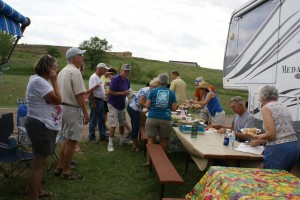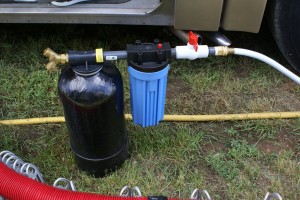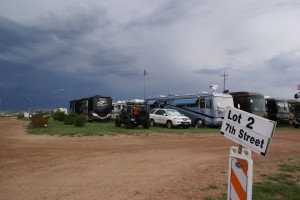Today was laundry day, so after breakfast we gathered up clothes and linens. During the morning Peter & Sybil pulled out of the spot on our passenger side and shortly thereafter Ed & Rosemary pulled in (50A, full hookup). Linda left to do laundry, post office, and grocery store errands while I stayed with the coach and cats. Charles & Connie Martin, another couple from our FMCA GLCC chapter, pulled in across from us with their MCI 102C3 bus conversion. They were apparently given a hard time about parking at Windmill RV Park and were told they had to be on the west side of the paved road, which is only 30A & water (no sewer hookup). When we made arrangements with the CAM-PLEX to stay between the rallies they clearly told us we could move to Windmill anytime after 10 AM on Sunday and that 50A full-hookup sites where first come, first served. They even gave us a parking sign to put on our dash. It became apparent that there was some confusion as to who was supposed to park where.
I got on my computer (not literally, of course), went into the WiFi Ranger control panel, and reduced the power from “high” (the default) to “medium.” According to the manual (available online), the connection can sometimes be improved by using less power. I still had full/excellent signal strength in the bedroom, so I was not sure which radio this setting controls, or if it controls both, or if there are even two radios. I will probably try low power to see how that works, and talk to the WiFi Ranger folks about it when next we meet.
I worked on finishing my draft blog post for the previous day, and then went to work on hooking up the rear OTA TV antenna/rotator and TV set. My technological luck of the previous day ran out when the antenna failed its internal calibration process, and would not rotate. I went ahead and set up the TV, another 22″ Westinghouse LD-2240 (LCD/LED flat panel monitor) requiring an ATSC channel scan activation code. (Really, what’s up with that?) I was able to find and view most of the same channels we had up font, but the reception was not as good on some, probably because the antenna was not pointed in the right/best direction. A double check of the inside wiring confirmed that the RF & control cables were connected correctly, so the problem was either the roof unit wiring or the roof unit itself.
It was also possible that the problem was the rotator controller. I tested that possibility using the known-good front unit, but the rear antenna still wouldn’t calibrate. Soooo, back up on the roof to check the wiring to the antenna. The connections are on the rear underside of the housing, which is mounted on top of two brackets that place the underside about 8″ above the lower rear roof tray and just above the main roof. If you are short (I am) and flexible (not as much) there is just enough room to lie down, reach under, and use a short screwdriver. All of the wires were connected to the correct terminals, but I loosened and re-tightened them anyway, including the coax. I climbed down and retested the system, and this time it not only failed to calibrate, it displayed “Er” on the LCD. That’s what I call “negative progress!”
The installation and operation instructions indicated that the problem could be: 1) that the black wire was not connected (it was, on both ends), or 2) that something was blocking the rotor. In the later case that “something” would have to be inside the sealed antenna enclosure. However, warnings elsewhere in the instructions tell you, emphatically and in no uncertain terms, that the insides of the system are dangerous (high voltage) and that it should not be opened as there are no user serviceable parts inside. Huh? So how do I unblock the rotor?
(BTW: these are HD View 360 antennas from AntennaCrafters. There was an older model of this antenna on the coach when we bought it. It was designed primarily for the old VHF/analog TV signals and not optimized for the new UHF/digital ones. The rotation feature also no longer worked, but we liked the sealed, “flying saucer” design in which the rotating antenna parts are in a flat, weather-sealed enclosure that is fairly aerodynamic going down the road. I believe the antenna is an “active” design and provides some amplification of the signal it receives, but I am not absolutely sure of that. The new model has a controller with an RF remote and is designed to pick up the newer digital signals as well as the legacy analog stations that are still operating in some areas. Even though I was putting these two antennas in service for the first time, they were way out of warranty (90 days) as I had purchased them back in 2012 when we were having the roof redone and the coach repainted. Based on my sample of two, it appears that AntennaCrafters has a 50% failure rate on this model. I also have the problem that I bought these antennas from two different sources at two different times, and I don’t which one is which.)
At this point I will probably open up the rear antenna case. After all, with electrical engineering degrees and amateur radio licenses, I figure I’m qualified to do this without endangering my life. But with a storm approaching, that wasn’t going to happen right away. We closed up the coach and turned on the two front air-conditioners to try to keep the interior comfortable as the forecast high was 91 degrees F. The temperature outside was only 82 degrees F, but the sun was intense and the inside temperature was headed for 90.
We sat outside for awhile as it was cooler than inside, and watched a large thunderstorm develop northwest of Gillette. It was drifting to the northeast, but also expanding in size. As the southeast edge neared our location, and the winds picked up, we decided to put all of the awnings up and put the fold-up camp chairs away, not wanting to risk getting caught with them out should the storm change course and get cranked up. We stood outside and talked to Ed and Rosemary while we watched the storm develop all around us. It eventually started to sprinkle where we were so we went inside and soon had a heavy downpour that lasted for 15 -20 minutes. The winds were not overly strong, and our skylight leak (slow drip) did not reappear. The storm eventually moved on to the east. Besides the drama and beauty, the upside of the storm was that it blocked the sun and brought cooler air, both of which helped keep the outside temperature down and the coach more comfortable.
I have loved western thunderstorms since I first encountered them as a boy traveling with my parents. The combination of isolated development and unobstructed views to expansive horizons allows you to watch them develop for a long time as they move across a considerable distance. This is rarely the case back in Michigan where storms develop along frontal boundaries and are often embedded and obscured from view. Also, except in some flatter/cleared agricultural areas, views are not as expansive as in the west due to the extensive tree cover.
After dinner, and with the storm moved off to the east, I went back up on the roof to work on the rear antenna. The enclosure is held together by 8 screws inserted from underneath, but it is high enough above the roof to allow for a 4″ long screwdriver to be used. I had disassembled our old one when it was removed from the coach, so I had some idea of what to expect inside. The physical design hasn’t changed much, but the rotor was definitely binding. With nothing to lose, I moved it by hand and got it freed up, although I have no idea what, if anything, I may have broken in the process. I had Linda apply power to the controller, being careful not to come in contact with any of the deadly voltages I had been warned about in the instructions. It completed the calibration process this time and gave a direction number on the LCD. Success! (Maybe?) I had her cycle it several times, and it calibrated successfully each time, but the rotor was not consistent as to its position. I then had her slowly step through the 16 positions, up and down, several times. Based on what I saw, it appeared that position 1 is just to the driver side of the front of the bus. As the numbers increase the rotor turns counterclockwise, with position 16 just to the passenger side of the front of the bus. So positions 1 -4 appear to be port side bow quadrant, 5 – 8 port side stern quadrant, 9 – 12 starboard side stern quadrant, and 13 – 16 starboard side bow quadrant. This is, of course, with the double-headed arrow on the enclosure pointing towards the front (bow) of the coach. Both antennas are mounted this way, but since I moved the rear rotor by hand, its position may not be correct. It was also not as repeatable in its positioning as it should be, especially around positions 7 – 10, so the front one may not orient the same way. Since the instructions are absolutely silent regarding how the pointing direction corresponds to the number on the controller display, I will ultimately have to take the front enclosure apart and visually determine how it works. That would be easier, of course, if it wasn’t 8 inches above the roof and 13 feet off the ground at the time.
While I was on the roof, Bob Pinner stopped by. Bob and Molly are the Escapade Directors for The Escapees RV Club. He confirmed rumors we had heard earlier in the day relative to parking issues. It turned out that the Escapade had lost the use of three RV parks at the CAM-PLEX due to the damage done by the motorhomes departing the FMCA rally. The SKP’s had not planned on using Windmill RV Park, but now needed it for their staff and volunteers as well 30 A electric (only) registrants. It was obvious that Bob was trying to re-plan a lot of things at the last minute so we agreed to move our coach the next day. The decision was to move us back to the Boxelder RV Park, where we would have full hookups, and a good chance of 50 A power. We figured the sooner we moved the better site selection we would have, so we agreed to move first thing the next morning (8 AMish).
In spite of the issue with the rear TV antenna, we were able to use the rear TV and simultaneously watched different TV programs for the first time in quite a while as we do not currently have OTA, cable, or satellite TV at home and we do not have satellite TV in the coach. Gillette has PBS and Create, so this was the first time it felt a little bit more like living in the coach and a little bit less like being on vacation. The fact that we are between rallies with no pressing need to be anyplace specific, or do anything in particular, also contributed to this feeling.


